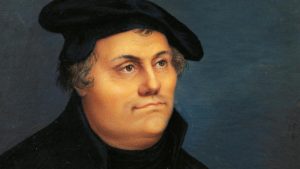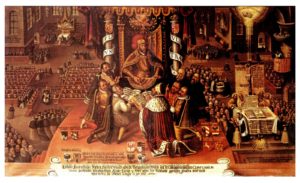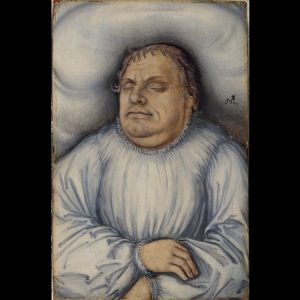Around 1400 Johannes Gutenberg, inventor of movable type printing around 1435, was born (died in 1469). His invention allowed the rapid spread of Reformation ideas.
 1483 Martin Luther was born in Eisleben, Saxony. Later, in a visit to the town of his birth, he died.
1483 Martin Luther was born in Eisleben, Saxony. Later, in a visit to the town of his birth, he died.
1509 John Calvin was born (died in 1564). Calvin would first be won to the Lutheran Reformation, then break over questions on the Sacraments, the person of Christ, and other issues. His Institutions of the Christian Religion is a foundational document for the Reformed tradition.
1517 Luther nailed his Ninety-Five Theses to the door of the Castle Church in Wittenberg on October 31. His goal was to start discussions about indulgences and other questionable practices of the Catholic Church in order to reform (fix) it.
1520 Pope Leo X issued a “papal bull” giving Luther sixty days to recant (take back what he had said against the Roman Catholic Church). Luther later burned the bull publicly.
1521 Luther was excommunicated (kicked out of the Catholic Church) by Pope Leo X.
1525 The Anabaptist movement began when a group of people who had been baptized as infants gathered to be rebaptized as adults. Mennonite, Amish, Hutterite, and Brethren groups of today are Anabaptists.
1526 At the Diet of Speyer, German princes were given the right to choose whether their territories would be Roman Catholic or Protestant.
1529 Luther published his Large and Small Catechisms. He wrote the catechisms after he visited Saxony and realized how little most Christians and even most pastors knew about God and the Bible. The Small Catechism became an instant bet-seller.
 1530 The Augsburg Confession was prepared by Philip Melanchthon to explain what Lutherans believed. It was presented to Emperor Charles V by a group of Lutheran princes at the Diet of Augsburg in June. The emperor did not like what was said in the Augsburg Confession and his Roman Catholic advisors prepare his response,, the Pontifical Confutation of the Augsburg Confession. It explained what they thought was wrong with the Augsburg Confession.
1530 The Augsburg Confession was prepared by Philip Melanchthon to explain what Lutherans believed. It was presented to Emperor Charles V by a group of Lutheran princes at the Diet of Augsburg in June. The emperor did not like what was said in the Augsburg Confession and his Roman Catholic advisors prepare his response,, the Pontifical Confutation of the Augsburg Confession. It explained what they thought was wrong with the Augsburg Confession.
Philip Melanchthon spent about half a year preparing the Apology of the Augsburg Confession in which he worked through each of the points of the emperor’s confutation and explained the errors in the confutation and the truth in the Augsburg Confession.
1531 The Augsburg Confession and the Apology of the Augsburg Confession were published.
1534 Henry VIII created the Church of England (origin of Anglicans). Society of Jesus (Jesuits) is founded by Ignatius of Loyola.
1538 Martin Luther’s Smalcald Articles were published. Luther had been asked to prepare a statement of faith that would clearly explain the difference between Lutheran and Roman Catholic beliefs.
Pope Paul III decided to call a council to discuss how to reform the Catholic Church. The Council of Trent met between 1545 and 1563.
1540 Philip Melanchthon’s Treatise on the Power and Primacy of the Pope was published. In it, Melanchthon pointed out three main false teachings about the pope.
 1546 Soon after Martin Luther died (February 18, 1546), Pope Paul III and Emperor Charles V made an agreement to stop the Protestant Reformation and force the Lutherans to become a part of the Catholic Church again. The Smalcaldic War broke out. By the middle of 1547, the emperor had defeated all the Lutheran princes. Philip Melanchthon decided to compromise some of his beliefs in an effort to get along with the pope and the emperor. Lutherans became split between those compromising like Melanchthon and those who held tightly to what they believed.
1546 Soon after Martin Luther died (February 18, 1546), Pope Paul III and Emperor Charles V made an agreement to stop the Protestant Reformation and force the Lutherans to become a part of the Catholic Church again. The Smalcaldic War broke out. By the middle of 1547, the emperor had defeated all the Lutheran princes. Philip Melanchthon decided to compromise some of his beliefs in an effort to get along with the pope and the emperor. Lutherans became split between those compromising like Melanchthon and those who held tightly to what they believed.
1552 The Elector of Saxony drove the emperor and his troops out of Saxony. Two treaties, in 1552 and 1555, gave religious freedom back to the princes.
1560 The Church of Scotland broke from the Roman Catholic Church (origin of Presbyterians).
1563 The Council of Trent met for the last time after making many decisions about official beliefs and practices of the Roman Catholic Church.
1576 The Epitome of the Formula of Concord was completed at the Torgau Conference. Six Lutheran theologians, including Martin Chemnitz, met to create a document they hop0ed would end the theological disagreements between Lutherans who were compromising with the pope on some articles of the Augsburg Confession and other Lutherans who were trying to hold to everything Luther taught based on the Bible.
1577 The Solid Declaration of the Formula of Concord was completed. The Solid Declaration is a longer, more detailed version of the Epitome.
1580 The Book of Concord was published exactly fifty years after the Augsburg Confession was presented at the Diet of Augsburg. Over eight thousand signed it to show that they agreed with everything in it.
